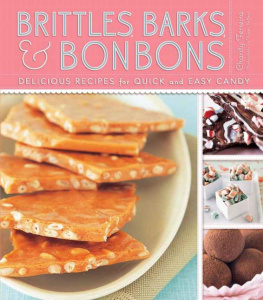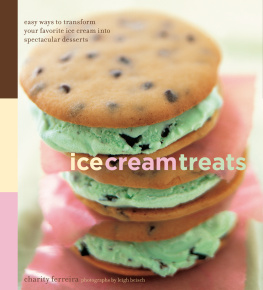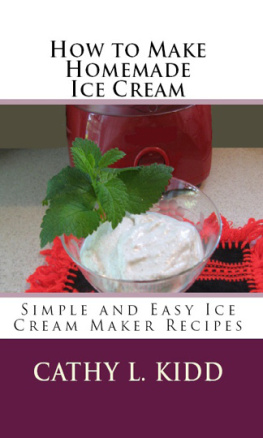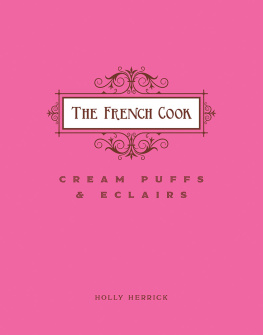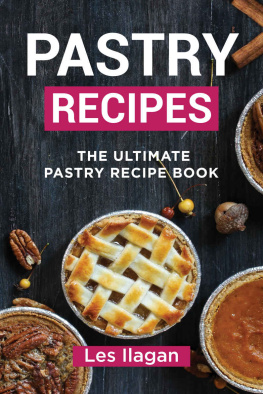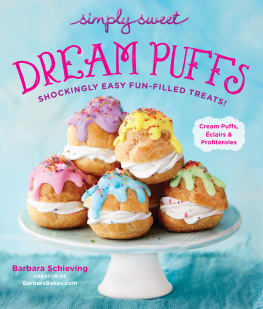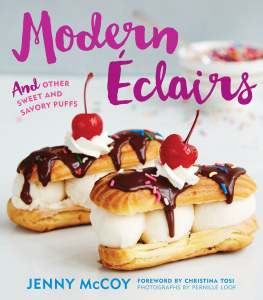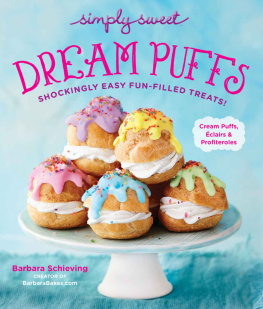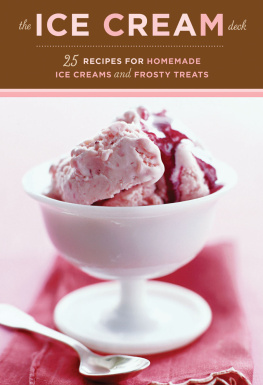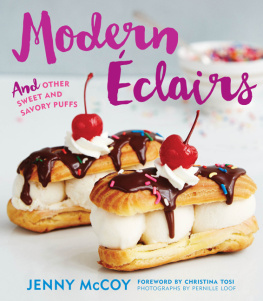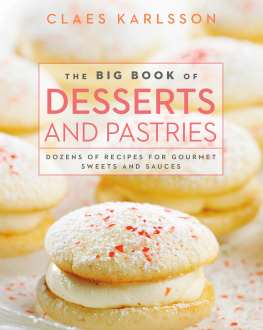


acknowledgments
This was a fun book to write, and I was extraordinarily lucky to have been able to draw on the expertise and endless patience of my friend Debbie Hughes, who tasted batch after batch of chocolate pastry cream until I was satisfied I had the glossy, rich version I was going for. A big thank-you goes to my testers and tasters, especially those of you who stayed until the wee hours eating endless gougres (you know who you are!). I especially want to thank Marlene Kawahata and Maryanne Welton, who meticulously tested recipes and provided invaluable insights and suggestions. And last but not least, thank you Dylan, for your enthusiasm and your help, and for requesting clairs for your birthday dessert!
Text copyright 2016 by Charity Ferreira.
Photographs copyright 2016 by Joseph De Leo.
All rights reserved. No part of this book may be reproduced in any form without written permission from the publisher.
ISBN 978-1-4521-5072-7 (epub, mobi)
Library of Congress Cataloging-in-Publication Data available.
ISBN 978-1-4521-4566-2 (pb)
Designed by Vanessa Dina
Photo assisting by Kazuhito Sakuma
Food styling by Liza Jernow
Food assisting by Kristin Miglore
Typesetting by Frank Brayton
Chronicle Books LLC
680 Second Street
San Francisco, California 94107
www.chroniclebooks.com
introduction
If youve never tried making clairs or havent made them in years, its time! The clairs you remember have been nudged into the twenty-first century and are now bursting with bold new flavors and bright colors.
clairs and their cousinsprofiteroles, cream puffs, and savory gougresare made from pte choux, a dough that is the basis of many French pastries. When baked, it has a crisp yet tender exterior and an airy, slightly eggy interior that is made to hold rich, creamy filling. While pte chouxbased pastries look elegant, theyre not at all difficult to make at home.
The formula for successful pte choux reminds me of that old-fashioned American recipe for 1-2-3 pound cake that was so called because it was so easy to remember: 1 cup of butter, 2 cups of sugar, and 3 cups of flour. Pte choux has just a few ingredients, and the basic proportions are so easy to remember that if you make it a few times, youll know it by heart. If youre the kind of baker who loves exploring kitchen science, there are more than a dozen small variables that can affect how your choux pastry will come out, from the moisture in the air to the hot spots in your oven. And if you just want to make clairs without bothering about the details, the good news is that, if you follow a few simple guidelines, youll be able to make successful clairs on your very first attempt.
tools
To make pte choux, youll need a heavy-bottomed medium saucepan and a sturdy wooden spoon. A flexible, heatproof spatula is also handy for scraping every last bit of the batter from the pan.
If you have a kitchen scale, use one when youre making pte choux to check that your 1 cup plus 2 Tbsp of flour weighs 140 grams. And if you dont have a kitchen scale, youll do just fine if you stir up your flour a bit first, spoon lightly packed flour into the measuring cup, and level off the top.
You may have seen choux recipes that call for an electric stand mixer, but I prefer to simply mix by hand. Its one less bowl to wash afterward, and the choux really doesnt require the heavy beating that makes a mixer necessary.
I use a pastry bag with a 3/4-in [2-cm] round tip for piping out clairs and profiteroles and for filling them with cream. You can buy single-use plastic pastry bags that work well for this purpose at kitchen-supply stores. You could also spoon the choux or the filling into a zip-top plastic bag and snip off a corner.
For baking your creations, youll need a couple of heavy-duty baking sheets and baking parchment to line them. Choux pastries left to cool on a baking sheet turn out just fine, but, if you prefer, you can transfer the baked pastries to a wire-mesh cooling rack.
When it comes to making silky smooth pastry creams, citrus curds, and fruit sauces, youll want a fine-mesh strainer with a handle for straining your finished product. You can buy this kind of strainer at cooking-supply stores, and youll be surprised at what an indispensable tool it becomes! I reach for mine often, whether Im draining cooked pasta or fishing blanched veggies out of boiling water.
mixing
The process for mixing pte choux is simple. Bring water and butter to a boil, remove it from the heat, and stir in your flour, sugar, and salt with a wooden spoon until it comes together in a smooth mass. At this point youll return the pan to the heat and cook the mixture for 1 to 2 minutes to cook off some of the moisture. Then youll remove the mixture from the heat and let it cool for 5 minutes before adding your eggs.
Beating in the eggs is where many cooks are deterred, because when you add the first egg and start stirring, the mixture will look like a separated, curdled mess. Its not ruined! Keep stirring the mixture vigorously with the wooden spoon, and youll see that the egg will incorporate smoothly. Do this for all four eggs, one at a time, and by the end you will have a smooth, glossy mixture thats somewhere between a thick batter and a very soft dough. Give the mixture a good vigorous stirring for a few seconds after the fourth egg is incorporated. The amount you beat the pte choux at this stage affects how much your pastries will puff up in the oven. Beating the mixture extensively after the eggs are incorporated will give you clairs that are puffier than the long, slender baton-shaped clairs sold in French pastry shops. Not beating the choux enough will result in clairs that do not change much from the shape in which you piped them, and they will have a dense interior. Beating the mixture vigorously for a few seconds will result in clairs that are airy and lofty with a slender, defined shapein the words of Goldilocks: Just right.
Note that if youre making clairs for a crowd, its best to mix up each batch of choux separately, rather than doubling the recipe. The bigger the batch, the harder it is to incorporate the eggs by hand and get consistent results.
shaping
In this book youll find recipes for clairs, mini clairs, profiteroles, cream puffs, and gougres. A medium piping bag fitted with a plain 3/4-in [2-cm] tip is the easiest way to make consistently shaped pastries. If you dont have a pastry bag, a 1-gl [27-by-27-cm] plastic zip-top bag makes a fine makeshift piping bag, used either with or without a metal pastry tip.
To fill a pastry bag with choux, snip off the pointed end of the bag and slide in the metal pastry tip. Fold down the edge of the bag over your hand, like a collar, and use your other hand to spoon in the choux. Unfold the edge of the bag and twist the bag closed from the top, squeezing the choux down to the tip of the bag. If youre using a zip-top bag, spoon in the choux in a similar fashion. Twist the bag closed from the top and then use scissors to snip about 1/2 in [12 mm] off one bottom corner. You want an opening that is around 3/4 in [2 cm]. Begin piping out your choux by squeezing from the top as you twist the top of the bag further, forcing the choux down and out the opening.
Next page

